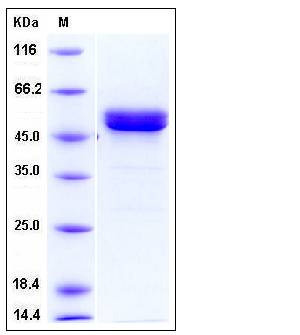Human MMP1 Protein (His Tag)
CLG,CLGN
- 100ug (NPP4084) Please inquiry
| Catalog Number | P10532-H08H |
|---|---|
| Organism Species | Human |
| Host | Human Cells |
| Synonyms | CLG,CLGN |
| Molecular Weight | The secreted recombinant human MMP1 comprises 461 amino acids migrates as an approximately 50-55 kDa band as estimated in SDS-PAGE under reducing conditions. |
| predicted N | Phe 20 |
| SDS-PAGE |  |
| Purity | > 96 % as determined by SDS-PAGE |
| Protein Construction | A DNA sequence encoding the pro form of human MMP1 enzyme (NP_002412.1) precursor (Met 1-Asn 469) was expressed with a C-terminal polyhistidine tag. |
| Bio-activity | Measured by its ability to cleave the fluorogenic peptide substrate, McaPLGL-Dpa-AR-NH2, R&D System, Cat#ES010. The specific activity is >400 pmoles/min/μg (Activation description: The proenzyme needs to be activated by APMA for an activated form) |
| Research Area | Immunology |Inflammation / Inflammatory Mediator |Inflammatory Disorders Therapeutic Targets |Rheumatoid arthritis Therapeutic Targets |
| Formulation | Lyophilized from sterile 25mM MES, 10mM CaCl2, 150mM NaCl, 0.05% Brij 35, pH 5.5 1. Normally 5 % - 8 % trehalose, mannitol and 0.01% Tween80 are added as protectants before lyophilization. Specific concentrations are included in the hardcopy of COA. |
| Background | MMP1, also known as MMP-1, contains 4 hemopexin-like domains and is a member of the matrix metalloproteinase (MMP) family. Matrix metalloproteases, also called matrixins, are zinc-dependent endopeptidases that are the major proteases involved in ECM degradation. MMPs are capable of degrading a wide range of extracellular molecules and a number of bioactive molecules. MMP activity is regulated by two major endogenous inhibitors: alpha2-macroglobulin and tissue inhibitors of metalloproteases (TIMPs). MMPs play a central role in cell proliferation, migration, differentiation, angiogenesis, apoptosis and host defences. Dysregulatoin of MMPs has been implicated in many diseases including arthritis, chronic ulcers, encephalomyelitis and cancer. Tumour metastasis is a multistep process involving the dessemination of tumor cells from the primary tumor to secondarys at a distant organ or tissue. One of the first steps in metastasis is the degradation of the basement membrane, a process in which MMPs have been implicated. MMPs are secreted by tumor cells themselves or by surrounding stromal cells stimulated by the nearby tumor. Numerous studies have linked altered MMP expression in different human cancers with poor disease prognosis. MMP-1, -2, -3, -7, -9, -13 and -14 all have elevated expression in primary tumors and/or metastases. MMP-1 cleaves collagens of types I, II, and III at one site in the helical domain. It also cleaves collagens of types VII and X. In case of HIV infection, MMP1 interacts and cleaves the secreted viral Tat protein, leading to a decrease in neuronal Tat's mediated neurotoxicity. |
| Reference |
